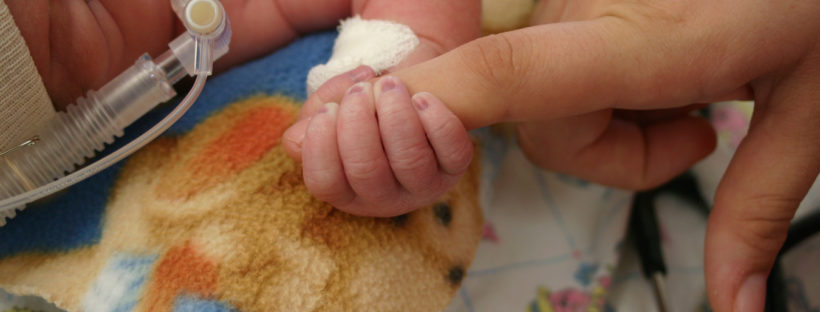 by, Jessica Grenon
by, Jessica Grenon
When I think back to the birth of my second child earlier this year, tears almost instantly begin to fill my eyes.
Unlike the birth of my first child three years prior, this isn’t because I am overjoyed by thoughts of holding my baby against my chest for the first time while I stare in awe at the life my husband and I created, a life that I grew in my own body and delivered into the world after many, many hours of hard labor. Instead my eyes fill with tears because I think of my labor and delivery nurse and how I believe her actions on that day affected the trajectory of my life, my son’s life, and the future of our family.
I am not a nurse, I don’t even work in the medical industry, but for the past nine years come June my work has brought me to the annual AWHONN convention, where I support the online system used by those submitting proposals and assist presenters’ presentations. Through this work I have read hundreds of abstracts and watched dozens of presentations on standard topics such as home births and skin to skin care for newborns, to more memorable subject matters like how to care for a vaginal piercing during a delivery.
My work with AWHONN does by no means make me an expert in the field of labor and delivery, but on January 30th of this year, I had gained enough knowledge from working with AWHONN to know what the possible outcomes could be when something suddenly went wrong during the birth of my son.
After 13 hours of laboring in the hospital, the time had finally come to begin pushing. Not yet knowing the gender of my child, I felt extra encouragement to push as hard so I could finally meet my baby. It took only 21 minutes of pushing to hear the words, “only one more push, Jessica, and you will be able to hold your baby!”, however, that was quickly followed by a sudden shout to stop pushing.
Stop pushing, but why? I looked down and between my legs I could see the head of my baby, turned toward my inner right thigh; he was silent and lifeless. Right away I knew that it was shoulder dystocia, and like any mother, my mind went to straight to thinking about the worst case scenarios. Was my baby getting oxygen, would he have brain damage? Is his shoulder going to be broken? I don’t care if he has broken bones, bones heal, just make sure he can breathe! Just last June at AWHONN a presenter and I had a conversation about shoulder dystocia, what was it that she said the other outcomes could be?
The next few minutes were all a blur me screaming at the doctor to help my baby, my husband kissing my head and doing the best he could to stay strong for the two of us, the student midwife attending her first delivery still holding onto my left leg waiting for someone to give her instructions and then there was a voice that I will never forget. Then the firm voice of my labor and delivery nurse as she turned to the doctor and said, “Doctor. Would you like me to call for another set of hands?” I got the sense that she wasn’t asking for permission, but rather she was politely informing the doctor of her intent to ask for assistance because she knew it was needed.
The doctor nodded as my nurse instantly took one side step closer to my head, she looked me straight in the eyes and smiled as she pushed the call button for the nurse’s station and requested another attending physician join us in my delivery room. A moment later the door swung open and the already crowded room began to fill with more people. In an instant, my nurse and another doctor were in the delivery bed with me, pushing on my low abdomen , doing all they could to change the position of my baby.
In this chaotic scene I once again heard that firm voice calmly say, “Doctor. Would you like me to call in a NICU team?”. The doctor nodded yes and soon a NICU team stormed into the room to wait for my son to be born to take over his care.
At the end of this ordeal, I was blessed with a perfectly healthy child; not one bruise on his body, no torn muscles, no broken bones, and no lack of oxygen to his brain. He did stay in the NICU for two days to be supervised for a potential infection, but otherwise all 10lbs, 5ozs of him was unscathed during his traumatic birth .
It may have been my doctor’s hands that brought my son into the world, but it was my nurse’s voice that I credit for my son’s health and our future without the need for further medical treatment.
Would my son have been fine if he were stuck during the birthing process for another couple of minutes? I don’t know. Fortunately because my labor and delivery nurse spoke up during a time of crisis, I don’t have to find out.
 Jessica L. Grenon is the Director of Continuing Education Services at The Conference Exchange, where she has worked with AWHONN since 2007. She, her husband, and their two young children enjoy traveling and spending time with their extended family, especially with her twelve nieces and nephews.
Jessica L. Grenon is the Director of Continuing Education Services at The Conference Exchange, where she has worked with AWHONN since 2007. She, her husband, and their two young children enjoy traveling and spending time with their extended family, especially with her twelve nieces and nephews.
Resources on Shoulder Dystocia
Definition: Shoulder Dystocia is the impaction of the fetal anterior or posterior shoulder behind the material pubic symphysis resulting in delay in a cephalic vaginal delivery. This creates a high-risk intrapartum complication affecting both mother and baby.
For Parents: Health providers can’t always predict or prevent shoulder dystocia, but there are some risk factors you can learn about.
For Nurses: AWHONN has a Shoulder Dystocia online product to help prepare clinicians for this level of critical care event.








 Michelle Collins is currently Professor of Nursing and Director of the Nurse-Midwifery education program at Vanderbilt University School of Nursing. In addition to the teaching and administrative aspects of her job, she maintains an active clinical practice as part of the Vanderbilt School of Nursing faculty nurse-midwifery practice. Currently she is a blogger for Nashville Public Television for the popular series Call the Midwife.
Michelle Collins is currently Professor of Nursing and Director of the Nurse-Midwifery education program at Vanderbilt University School of Nursing. In addition to the teaching and administrative aspects of her job, she maintains an active clinical practice as part of the Vanderbilt School of Nursing faculty nurse-midwifery practice. Currently she is a blogger for Nashville Public Television for the popular series Call the Midwife.

 Jessica L. Grenon is the Director of Continuing Education Services at The Conference Exchange, where she has worked with AWHONN since 2007. She, her husband, and their two young children enjoy traveling and spending time with their extended family, especially with her twelve nieces and nephews.
Jessica L. Grenon is the Director of Continuing Education Services at The Conference Exchange, where she has worked with AWHONN since 2007. She, her husband, and their two young children enjoy traveling and spending time with their extended family, especially with her twelve nieces and nephews.

 Lori is a NICU Staff Nurse at Sahlgrenska University Hospital in Gothenburg, Sweden. After becoming a nurse, Lori traveled across the country to work a three-month travel contract in San Francisco, California. Nearly five years later her journey continued to Gothenburg, Sweden, where she now lives and works.
Lori is a NICU Staff Nurse at Sahlgrenska University Hospital in Gothenburg, Sweden. After becoming a nurse, Lori traveled across the country to work a three-month travel contract in San Francisco, California. Nearly five years later her journey continued to Gothenburg, Sweden, where she now lives and works.


